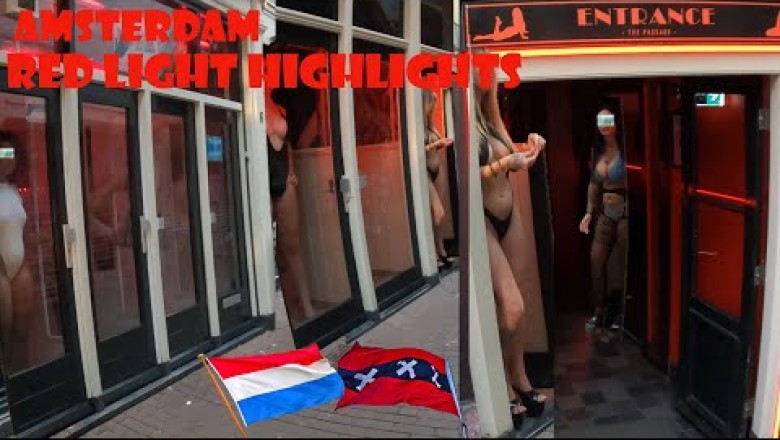
views
Amsterdam, Red light (Wallen) highlights. The best of Red light in a warm day
https://youtu.be/0kwBtawiB8cDe Wallen or de walletjes is a prostitution area in the oldest part of Amsterdam near Burgwallen Oude Zijde . Window prostitution is practiced in more than 300 workplaces . The neighborhood is referred to in English as the Red Light District , because of the red lamps that are traditionally lit in the windows of the prostitutes . It is one of the main tourist attractions of Amsterdam. The prostitution area measures approximately 250 × 250 meters and is bordered by the Lange Niezel and Korte Niezel in the north, the Zeedijk / Nieuwmarkt in the east, the Koestraat / Sint Jansstraat in the south and the Warmoesstraat in the west. Prostitution takes place in the Barndesteeg, Bethlehemsteeg, Bloedstraat , Dollebeguinensteeg, Enge Kerksteeg, Goldbergersteeg, Gordijnensteeg, Molensteeg, Monnikenstraat, Oudekerksplein , Oudekennissteeg, Oudezijds Achterburgwal, Oudezijds Voorburgwal, Sint Annendwarsstraat, Sint Annenstraat, Stoofsteeg and Trompettersteeg. The area also houses sex shops , the Casa Rosso erotic theater , the Banana Bar , the Hash Marihuana & Hemp Museum , and coffee shops . The Red Light District is located in the oldest part of Amsterdam. The Oude Kerk , the city's oldest surviving building, and the Warmoesstraat date from the 13th century. Before 1385, Amsterdam was shielded in the west with a moat (now the Nieuwezijds Voorburgwal ) with an earthen wall with palisade beyond it , and the same in the east (now the Oudezijds Voorburgwal ). About 1385, Amsterdam's fortifications were expanded beyond it with new moats with ramparts: Nieuwezijds Achterburgwal (now the Spuistraat ) to the west and Oudezijds Achterburgwal to the east. This is how the area was created that was called "de Wallen" in the twentieth century. Until 1578, the Oudezijde area was characterized by many monasteries . After the Alteration , the monasteries of the new, predominantly Calvinist city council were given other uses, such as an orphanage or a prison . Already at an early stage, in the 15th century or earlier, prostitution took place in the somewhat broader Oudezijde area , perhaps not exactly in the streets where prostitution is today. Since then, prostitution has never gone away. [3] Since the 15th century or earlier, brothels and other prostitution establishments can be found at least in the Oudezijde area , regularly also in other parts of the city. Since 1578, fornication or facilitation has regularly been criminalized in Amsterdam and those involved were chased away. At the end of the 19th century, and still around 1920, the Zeedijk and the adjoining Red Light District were completely dilapidated, but prostitution was also practiced then, partly street prostitution . Window prostitution was already taking place in the 1930s . Prostitutes were not allowed by the police to lure customers into the doorway, but they were allowed to sit behind the window with the curtains slightly ajar. From the 1960s, prostitution increased sharply in the Red Light District. In the summer of 2007, the Coalition Project 1012 ( Project 1012 for short ) was launched. The municipality and the Centrum district worked together to reduce crime and to improve the economic value of the 1012 postcode area. The plan area is bordered by Singel , Kloveniersburgwal and Geldersekade . In 2009, the city council agreed to designate window prostitution as a criminal industry (see History of prostitution in Amsterdam ). Subsequently, the city council decided in 2011 to chase the window brothels from, for example, Sint Annenstraat and Oudekerkspleinand environment. The municipality expected to help women who were forced into prostitution. In 2018, the Amsterdam Court of Audit concluded that the government's Red Light District project had not succeeded. Despite the closure of 112 windows and 48 coffee shops , the forces of the market, driven by increased visitor flows and tourism, could not be contained. In recent years, law enforcement in the area has become a concern for the municipality. Due to the strong growth in tourism , the crowds, especially in the evenings, have increased sharply. Partly to limit nuisance caused by the throngs of tourists, it was announced in March 2019 that guided tours will no longer be allowed there from 2020. In July 2019, mayor Femke Halsema announced a new approach to get the excesses of crowds, nuisance and human trafficking under control. Source:Wikipedia




















Comments
0 comment